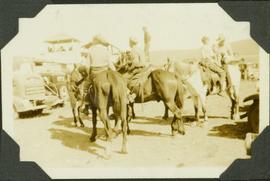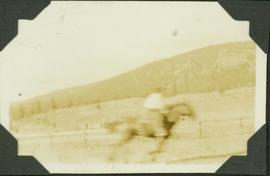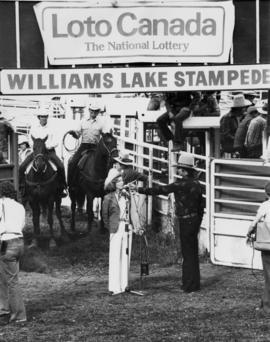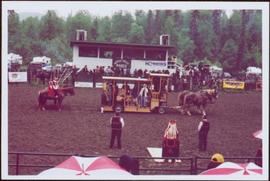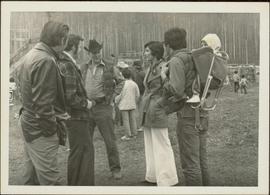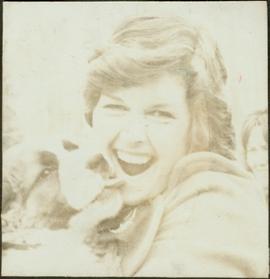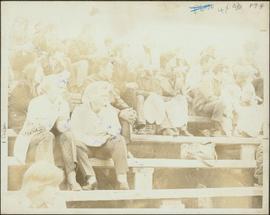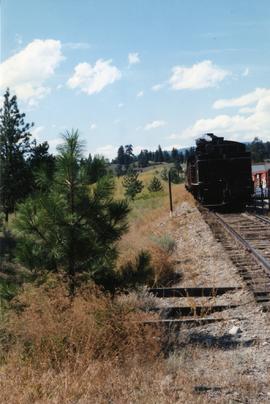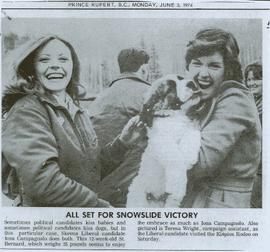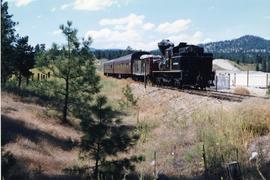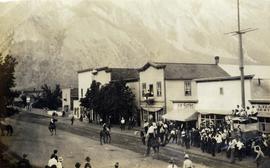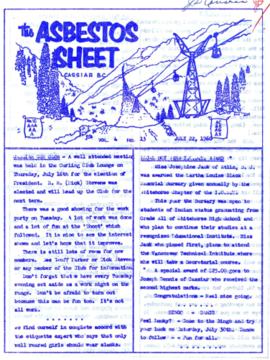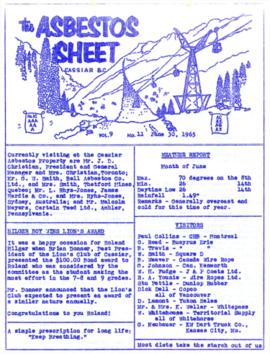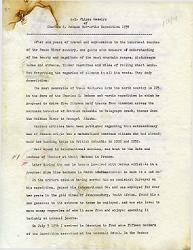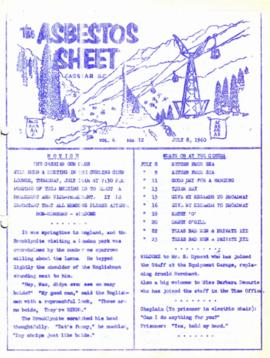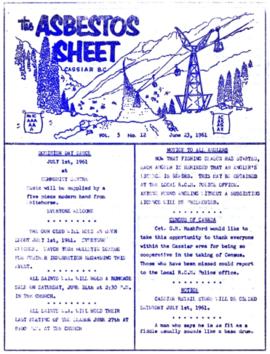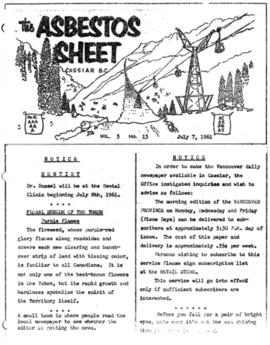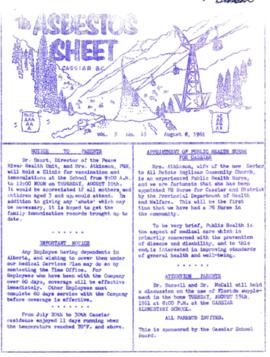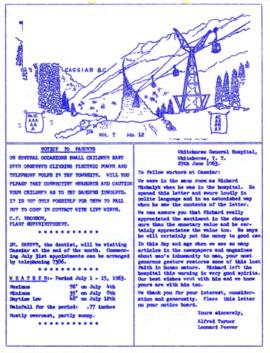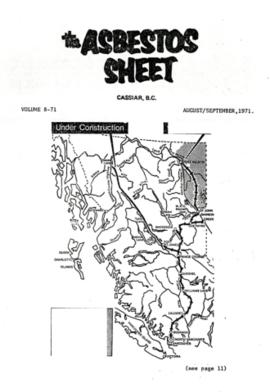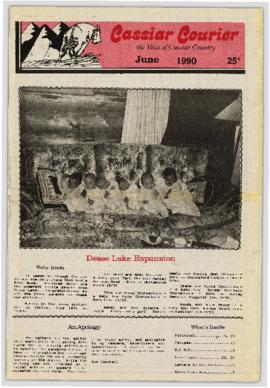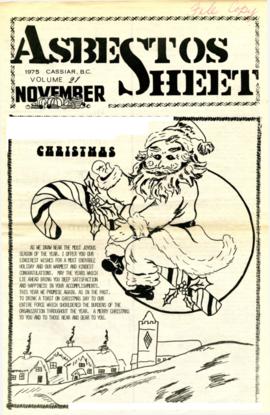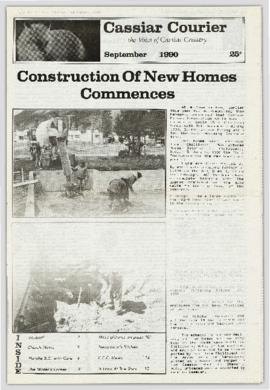Footage of the Anahim Stampede. The film includes recordings of the people at the stampede, bronco and bull riding, the area surrounding the arena, wild cow milking, children games such as sack races, horse racing around the arena, the concession stand and wild cow riding.
Caption: Williams Lake Stampede, caribou country. Most of the horses aren't much for looks, but they have other qualities. Item is a photograph of four boys (?) on horseback standing in a parking lot.
Caption: Williams Lake Stampede, caribou country. Speed? Note the open country; semi dry belt. Item is a blurred photograph of a man on horse back.
Digitized video clip of silent film footage depicts the Williams Lake Stampede and a parade.
This 16 page booklet includes illustrations and a program of events, along with a short history of Williams Lake, a short history of stampedes, a "Dude Dictionary", and a poem entitled "The Old Cow Puncher". Also includes a summary about the "Cariboo Indians" (possibly referring to the Secwepemc Nation and other First Nations near the Williams Lake area) contemporary to the time that contains information that is now considered inaccurate.
Footage of a horse ranch called "Cless Pocket Ranch" and hay fields surrounding. There is men at work using a sawmill to cut wood into planks and men working in the hay field with their young sons on the ranch. Cless Pocket Ranch is located in the Chilcotin area of BC near Anahim Lake.
Also included is footage of the Anahim Lake stampede, the people watching and playing, the arena and the concession stand.
Photograph depicts MLA Grace McCarthy speaking into a CKWL microphone at the Williams Lake Stampede.
Campagnolo holds microphone while wearing cowboy hat, and standing on a wagon pulled by team of horses.
Al Elsey compiled his original footage from 1965 to produce this commercial film that deals with trapping beaver, the Anahim Lake Stampede and Caribou migration. The video provides a compilation of film footage shot by Elsey and is narrated by him describing the activities documented in the footage
Footage of fly fishing on a river, possibly the Bella Coola River or Dean River, fishing in river canyon, footage of deer, footage of Alert Bay, village, marina and totem poles on shore, footage of a white robin, and a woman holding her salmon catch. Also include is recordings of the Anahim stampede and the bucking bronco event.
Crowd visible in background.
Handwritten annotation on verso reads: “Campaigning 1974 Kispiox".
Al Elsey compiled his original footage from 1964 to produce this commercial film that deals with the Anahim Lake Stampede, Caribou Hunting around Fenton Lake in Tweedsmuir Provincial Park, and Burton and Josephine Robson with their domestic deer. The video provides a compilation of film footage shot by Elsey and is narrated by him describing the activities documented in the footage
Film begins with recording of geese flying in sky as introduction. Then there is footage of community life in the general store, believed to be "Christensen's General Store," including a man lighting a pipe, children buying snacks and families buying groceries. Afterwards there is filming of the Anahim Stampede, depicting wild cow riding, bronco riding and the spectators.
The second portion of the film begins with the title slide "Caribou Return" and in consists of clips of ducks on a lake, scenery of trees and the lake, men packing up horses as they prepare for a journey into the high country. They travel as a pack train up into the mountains and eventually set up camp. There is footage of the men cooking, and also various shots of wildlife including a white grouse, herd of caribou, moose wandering through the snow, and a porcupine. The hunting party eventually kills a bull moose and there is footage of them examining the kill and loading the pack train with meat.
The third portion of the film begins with two young girls playing in a boat and then playing in a garden, and then a young boy pulling his sister in a wagon. There is a family barbeque and more footage of children playing and going fishing in a lack. The film ends with a recording of a grouse or pheasant in a bush.
Locations believed to be filmed in on this reel include Gitcha Mountains, Ulkatcho Mountains, Holt Homestead, Lassard Lake, Rainbow Mountains or Tweedsmuir Provincial Park.
Collection consists of digitized home videos created by the Viksten family. The videos include scenes of Horsefly Lake and the Williams Lake Stampede.
Accompanying handwritten note on UNBC Chancellor’s letterhead reads: “1974 Campaign, Kispiox Rodeo with Neil Sterritt”.
Photograph taken from a grade crossing that went into the Rodeo Grounds in Summerland. Locomotive belonged to the Kettle Valley Railway Heritage Society.
This file consists of 4 copy prints and negatives depicting the Williams Lake townsite, Stampede, and Chimney Creek bridge.
This clip of original film footage depicts depicts the Williams Lake Stampede and Pacific Great Eastern Railway (PGE) track inspection.
Caption below entitled: “All Set for Snowslide Victory,” and reads: “Sometimes political candidates kiss babies and sometimes political candidates kiss dogs, but in this particular case, Skeena Liberal candidate Iona Campagnolo does both. This 12-week-old St. Bernard, which weighs 25 pounds seems to enjoy the embrace as much as Iona Campagnolo. Also pictured is Teresa Wright, campaign assistant, as the Liberal candidate visited the Kispiox Rodeo on Saturday.”
Photograph taken at the temporary upper terminus at the Prairie Valley station (near the Rodeo Grounds). The tourist train originally started with 4 kilometers of track, but in September 1996, it increased to 10 kilometers by continuing past Summerland to the Rodeo Grounds. Turn-around siding was also installed beyond the new terminus. The first train went over the new track on August 22, 1996. Summerland was down grade to the right of the photo.
Videotape contains footage of: 14-Jan-00 - Northern Timberwolves Basketball - Bondaroff, Jenn; Blanks, Shannon; Sevingny, Brent / 19-Jan-00 - UNBC Rodeo Club - Darney, Jack
Videotape contains footage of: 2-Oct-97 - RRT Advisory Committee - Rutledge, Ron / 5-Oct-97 - UNBC Rodeo Club - Chiarello, David; Houston, Greg / 7-Oct-97 - APEC Forum - Bowles, Paul; Zwiers, Arnold; Ji, Shaobo / 7-Oct-97 - Genealogy Presentation to CSTC - Farrell, Elaine; John, Ed
Photograph depicts an event on Lillooet Main Street with spectator crowds. The Union Jack and Canadian Red Ensign flags suggest this may be a Dominion Day event. The Lillooet community put on large, multi-day Dominion Day events between 1912 and 1916 with many planned activities. The particular activity depicted in this photograph may be a horse race or rodeo-type event. Main Street businesses visible include the Lillooet Restaurant, the Lillooet Pool Hall, and the "OK" Baths.
This film reel of original footage depicts various views of the Pacific Great Eastern Railway, including:
- Pacific Great Eastern Railway (PGE) Budd Car from Shalath and Seton Lake to Kelly Lake
- Laying Pacific Great Eastern Railway (PGE) Track in Northern British Columbia
- Pacific Great Eastern Railway (PGE) Track Inspection with V-10 Vehicle
- Pacific Great Eastern Railway (PGE) Track Inspection with V-8 Vehicle
- Cariboo Williams Lake Stampede and Pacific Great Eastern Railway (PGE) Track Inspection
Digital video recording is an episode of Spotlight on UNBC from February 2000. Features segments on the suicide of Russian exchange student Anna Sorkomova; a conference on rural health; UNBC research forests Johnson Prince Research Forest north of Fort St. James (co-managed by UNBC and Tl'azt'en Nation) and Aleza Lake Research Forest east of Prince George (co-managed by UBC and UNBC); construction of the Irving K. Barber Enhanced Forestry Lab; UNBC involvement in the University of the Arctic; the annual UNBC Winterfest; UNBC Rodeo Club; the UNBC Nordic Ski Team at the Western Canadian Championship; UNBC Northern Timberwolves Men's Basketball; the proposed Northern Sports Centre; and the UNBC laboratory space expansion. Includes interviews with Charles Jago (UNBC President); Penny Priddy (BC Health Minister); Kwadwo Asante (Terrace pediatrician); Steve Dewhurst (UNBC Forestry); Justa Monk (Tl'azt'en Nation); Don Roy (Canfor Fort St. James); Sue Grainger (UNBC Research Forest Manager); Terry Carter (PG Soccer); Andrew Petter (Minister of Advanced Education; Paul Ramsey (Finance Minister); and UNBC students and alumni Christine Brock (Forestry), Scott Forrest (University of the Arctic), Jack Darney (UNBC Rodeo Club), Chris Paulson (UNBC Nordic Ski Team), Noah Huntley (UNBC Nordic Ski Team), Wendy Giesbrecht (UNBC Nordic Ski Team), Brent Sevigny (men's basketball), and Jenn Bondaroff (women's basketball).
Digital video recording is an episode of Spotlight on UNBC from November 1997. Features segments on a conference hosted at UNBC regarding the influence of the Asia-Pacific economy on Northern BC's economy; Carrier Sekani Tribal Council genealogy records to be stored at UNBC; UNBC open house on research called "UNBC Works"; the unveiling of the UNBC Timberwolves logo; the UNBC Rodeo Club; and the official opening of the Greenway Trail. Includes interviews with Don Munton (UNBC International Studies); Paul Bowles (UNBC Economics); Arnold Zwiers (Canadian Woodworks); Chief Edward John (Carrier Sekani Tribal Council); Gerald Wiesner (Bishop of Prince George); Paul Ramsey (Minister of Forests); Robin Draper (Greenway Society); Ahmed Hussein (UNBC Physics); Jim Leonard (UNBC Counsellor); Peter Whitridge (UNBC Anthropology); Peter Jackson (UNBC Environmental Studies); Gordon Ternowetsky; David Dick (UNBC Lab); Jill Craig (UNBC Lab); Ken Prkachin (UNBC Psychology); Marianne Ainley (UNBC Women's Studies); Charles Jago (UNBC President); Jim O'Meara (UNBC Recreation Coordinator); and UNBC students David Ing, Manmohan Singh, David Chiarello, Greg Houston, and Sam Zirnhelt.
Collection consists of three original color film reels that compile footage clips from various dates. Subjects include the following:
Premier W.A.C. Bennett on the PGE Railway:
- Vancouver to Prince George Trip with Premier Bennett, 1958
- Fort St. James Opening of Line with Premier Bennett, 1 August 1968
- Opening of Squamish Car Shop with Premier Bennett, 1970
- Fort Nelson Opening of Line with Premier Bennett, September 1971
- First Revenue Train South from Fort Nelson with Premier Bennett, 1971
PGE Track Inspection and New Construction:
- V-8 PGE Track Inspection
- V-10 PGE Track Inspection
- V-10 Track Inspection
- Fort Nelson South to Fort St. John, October 1971
- Cariboo, Williams Lake Stampede, and PGE Track Inspection
Seton Lake:
- Seton Portage Steam Train Wreck Recovery, 1 April 1954
- Open Air Passenger Cars riding along Seton and Anderson Lake
- Budd Car from Shalath and Seton Lake to Kelly Lake
- Budd Car running along Seton Lake
File contains speeches, memoranda, draft memoranda, event programmes, event itineraries, and background material. Includes:
- Canadian Hard of Hearing Association Conference Opening Reception, Kelowna, June 2, 2005
- Simon Fraser University Spring Convocation Ceremony, Burnaby, June 3, 2005
- Day of Portugal Celebration, Victoria, June 4, 2005
- Northwest Trip (Smithers, Kispiox Rodeo, Hazelton, Terrace) June 5, 2005
- Northwest Trip (Terrace) June 6, 2005
- Northwest Trip (Terrace, Kitimat) June 7, 2005
- Memorandum re: Northwest Trip (Terrace/Vancouver) June 8, 2005
- Cape Lazo Middle School Visit, Comox, June 10, 2005
- Vancouver Island Military Museum New Expansion Opening, Nanaimo, June 15, 2005
- Swearing-in Ceremony of the Premier and Cabinet of the Government of B.C., Victoria, June 16, 2005
- Creative Peace Mural Project Display and Reception, Victoria, June 16, 2005
- 2005 B.C. Legislative Interns Visit, Victoria, June 17, 2005
- The Victoria Foundation Reception, Victoria, June 17, 2005
- Lifeboat Naming and Dedication Ceremonies (Cape Ann & Cape Edensaw), Victoria, June 23, 2005
- 2005 Victoria Tall Ships Festival, Official Welcome and Opening Ceremonies, Victoria, June 23, 2005
- June 23, 2005 - calendar print out
- B.C. Special Olympics 2005 Provincial Summer Games Opening Ceremonies, Courtenay, June 23, 2005
- June 24, 2005 - calendar print out
- St. John House Opening Ceremony, Nanaimo, June 24, 2005
- June 25, 2005 - calendar print out
- Shawnigan Lake School's Closing (Graduation) Day, Shawnigan Lake, June 25, 2005
- Notecard to Iona Campagnolo from Joy Illington, re: recent visit, June 28, 2005
- Order of British Columbia Dinner, Victoria, June 29, 2005
- Presentation for Investiture and Reception - Order of British Columbia, Victoria, June 29, 2005
"The Asbestos Sheet" is a newspaper that documents the community and work life of the residents of Cassiar BC. Content includes text and photographs, as well as jokes, comics, and games.
"The Asbestos Sheet" is a newspaper that documents the community and work life of the residents of Cassiar BC. Content includes text and photographs, as well as jokes, comics, and games.
Item consists of a typewritten report together with three earlier complete or partial drafts of this report “A. H. Phipps Memoirs of Charles E. Bedaux Sub-Arctic Expedition 1934” along with original notebook which includes 11 pages of handwritten notes about the expedition.
"The Asbestos Sheet" is a newspaper that documents the community and work life of the residents of Cassiar BC. Content includes text and photographs, as well as jokes, comics, and games.
"The Asbestos Sheet" is a newspaper that documents the community and work life of the residents of Cassiar BC. Content includes text and photographs, as well as jokes, comics, and games.
"The Asbestos Sheet" is a newspaper that documents the community and work life of the residents of Cassiar BC. Content includes text and photographs, as well as jokes, comics, and games.
"The Asbestos Sheet" is a newspaper that documents the community and work life of the residents of Cassiar BC. Content includes text and photographs, as well as jokes, comics, and games.
"The Asbestos Sheet" is a newspaper that documents the community and work life of the residents of Cassiar BC. Content includes text and photographs, as well as jokes, comics, and games.
"The Asbestos Sheet" is a newspaper that documents the community and work life of the residents of Cassiar BC. Content includes text and photographs, as well as jokes, comics, and games.
"The Cassiar Courier" is a newspaper that documents the community and work life of the residents of Cassiar BC. Content includes text and photographs, as well as jokes, comics, and games.
"The Asbestos Sheet" is a newspaper that documents the community and work life of the residents of Cassiar BC. Content includes text and photographs, as well as jokes, comics, and games.
"The Cassiar Courier" is a newspaper that documents the community and work life of the residents of Cassiar BC. Content includes text and photographs, as well as jokes, comics, and games.
Footage of mountains, possibly around Anahim Lake or the Atnarko river area in Tweedsmuir Provincial Park
File consists of notes, clippings, and reproductions relating to the Cariboo and Northwest Digest publication. Also includes a CD-R that contains Sedgwick's index spreadsheet and accompanying documentation about the publication.
File consists of the following items:
- "Mac" by D.L. Surveyor
- "Knox (Mac) McCusker: Dominion Land Surveyor" by E.L. Rutherford, V.C. Brink, R.S. Silver and M.Z. (Smokey) Neighbour
- Excerpts from Men and Meridians by Don W. Thomson
- Article re: Knox McCusker written on the occasion of his death (April 14, 1955)
- "McKusker (sic) to open up Blueberry Mountain Area" (Alaska Highway News, June 8, 1950)
- "McCusker was surveyor, big game guide….also rancher and trail blazer"
- "Knox Freeman McCusker" written on the occasion of his death (The Canadian Surveyor, July 1955)
- "Veteran Surveyor - Alaska Highway Stories"
- Memories of Knox McCusker by his oldest niece Betty (McCusker) Rutherford
- "Veteran Surveyor prefers horses for long bush treks" by Eric Young (Edmonton Journal)
- Eulogy for Knox McCusker read by Stanley D. Seif at Burch Presbyterian Church in Fort St. John, B.C.
- Eulogy for Gwendolyn Dorothy McCusker (July 1997)
- "Tropical Valley No Myth: amazing story of woman who lived there" by Thomas A. Wayling (Vancouver Sun)
- Photocopy of section of map: "Topographical sketch map showing route traversed by the Bedaux Sub-Arctic Expedition 1934 through the Rocky Mountains" (by Frank Swannell, March 27, 1935)
- Memories of Knox McCusker by Bill McCusker, his oldest nephew
- "There is always a reason; destiny made it a date. The corridor of the Alcan didn’t just happen" (Fort St. John publication)
- Article on Knox McCusker (ALS News, Winter 1983)
Footage of Robson feeding his deer. The location of the filming is believed to be Robson's home in Bella Coola.
There are three different sections of film footage on this reel.
The first is of two men and a young boy going fishing from a river bank, gutting and cleaning the fish they catch and baiting their hooks with mill eggs. There is more filming of three other men going down the river in a small boat and then banking it to fish. They gut and clean their fish as-well. They load their small boat into the back of a red pick-up truck after they are finished their day.
The second part of this film reel begins with a map of Tweedsmuir Provincial Park. Men on snowmobiles traveling to an abandoned log home and acreage. They then break through the ice on the nearby lake and begin to retrieve their previously set beaver trap, which has a caught beaver. The men then travel to a different location and set up a beaver trap. There is some additional footage of two moose in the snow as the men travel to a third location and retrieve another caught beaver from under the ice. The men return to their cabin and skin the beavers.
The third part of this film is footage of Anahim Lake village, birds in the area, wild flowers, cattle drive, children fishing on the river and swimming, a pelican on a lake, and people in a boat traveling.
Possible other locations of filming include Bella Coola River, Dean River, Ulkatcho, Ulkatcho Mountains, and Tweedsmuir Provincial park.
File consists of a transcript of an oral history interview with John and Bernice Trick.
Item is a audio interview recorded by Bridget Moran with Justa Monk.
Audiocassette Summary
00’ 10” Moran is talking to Theresa, Justa’s wife. Moran asks her what Corpus Christi means. Theresa tells her it is a place where First Nations people from the area planted trees in a big circle. It was a prayer circle where the bishop would say mass.
05’ 10” Moran asks Theresa about Sports Day in Fort St. James, which was more like a rodeo.
06’ 17” Moran is now talking to Justa. Moran asks Justa about trips to Babine Lake that Jimmy previously mentioned. Justa does not remember the trips, but he imagines they were very cold.
09’ 17” Moran asks Justa about the store Jimmy used to run. Justa tells Moran the store was operating on the store credit, hence the downfall of the business. They continue to talk about opening a store in Tachie that is operated by someone with a strong business mind.
13’ 37” Moran asks Justa about a family member from Burns Lake that his sisters previously mentioned. Justa tells her that the family member is an aunt.
14’ 34” Moran asks Justa about the residential school. She enquires about his ability to play hockey. Justa never wore skates until he attended residential school.
16’ 03” Moran asks Justa about fishing with a safety pin. He tells her that one Indian can eat anything.
16’ 53” They return to talking about residential school and if Justa had ever returned. He went back when he was forty-five to visit the area.
18’ 34” Moran asks about the house his family used to live in. Justa is not sure about his brother’s story regarding the Hudson’s Bay Company. He is sure that the house they lived in was built byt heir family.
21’ 01” Moran asks about Justa’s brother who passed away when he was quite young. Justa says his mother told him his brother fell off the roof and broke his neck. They talk about Justa’s brother, Teddy, being killed.
24’ 04” Moran asks Justa about the community making their own snowshoes. Justa tells her what they made the snowshoes out of – deer hide, cow hide, moose hide. Justa talks about going out on the trap line with his father in his homemade snowshoes.
26’ 21” Moran asks Justa about his previous employment from 1957 on. He gives a chronological account of his employment history until 1967, when he went to jail. After 1969, he continued to work. He always worked. They continue to talk about his past employment.
39’ 32” Moran asks Justa about his social life between 1957 and 1967. He tells her that he had a good time. He started to drink at seventeen.
40’ 53” Moran asks about Justa’s brother Teddy and their relationship. Justa tells her they were close, like twin brothers.
41’ 52” They talk about his alcoholism and how it led to fighting. Justa continues to talk about his drinking days and how much trouble it caused him. He also talks about how his parents tried to discourage drinking between him and his brothers. His parents were not worried about his sisters because they settled down early.
48’ 52” Justa talks about how often he saw his family, particularly his parents, during that time period. He says he always felt close to his family, no matter what happened.
50’ 27” Moran asks Justa about how he earned a dollar a week leading children to the residential school. They talk about his arm being broken in the last year he attended residential school. He talks about playing hockey throughout his time at residential school.
54’ 11’ Moran asks Justa about how the Kemano II Project is going. Justa said in an interview the process should stop entirely because people are resigning on the government’s side. Justa tells her they are going to publicly protest the project.
59’ 16” End of tape.
Item is a recording of an interview that Bridget Moran conducted with Elder Sophie Thomas and Elder Mary John on the circumstances surrounding the death of her niece, Coreen Gay Thomas who was hit by a car in Stoney Creek in 1976 by a white man. During the interview they are joined by Elder Mary John who also answers questions about Coreen’s death. In the remainder of the interview Bridget asks Sophie about her own life; Sophie talks about being “married off” at 16 years of age; and experiences at the residential school at LeJac.
Audiocassette Summary
Side 2
00’05” Moran asks Sophie about the night that Coreen died and how Sophie learned the news
06’00” Sophie explains who came and told her the news. Sophie describes having to go to the morgue and assisted the nurses in preparing Coreen’s body for burial before being brought back to the reserve for the funeral. Sophie recalls telling the youth who were witnesses to the accident to speak the truth when being interviewed by the RCMP.
07’00 Sophie talks about her reaction to hearing that there was not going to be an inquest into Coreen’s death. She talks about her decision to fight against this and recalls how she notified the BC Association of Indian Homemakers requesting its assistance and how it sent a representative member Kitty [Bell] with the BC Indian Homemakers who interviewed Sophie, other Stoney Creek members and accident witnesses and that a letter was sent to the Coroner urging an inquest. Bridget refers to an article in the PG Citizen newspaper quoting Sophie on her desire for an inquest and they discuss the context of this quote. Sophie talks about her encounter with the Judge to request an inquest. She talks about how he [Judge Eric Turner] had himself caused a hit and run accident and how this may have initially been his rationale not to have an inquest into Coreen’s death.
15’00 Bridget asks about how Coreen’s parents found out about the accident and why the RCMP didn’t notify them. Sophie and Mary John discuss the questioning of Coreen’s sister [Marjorie who was with Coreen at the time of the accident] at the RCMP headquarters in Vanderhoof. Mary John joins the interview and Bridget asks her how she found out about Coreen’s death.
20’00 Both Sophie and Mary talk about Coreen, that she attended St. Joseph’s School to Grade 7. They note she babysat for families in the community. Sophie notes that Coreen and her boyfriend were planning to marry after the baby was born as “that was our custom” and had bought their wedding rings. He was at the Williams Lake Stampede at the time of the accident.
Tape turned off momentarily.
24’00 Bridget then interviews Sophie about her own early married life and about getting married at age 16 and the reasoning for this. Sophie explains that she did not want to get married but that the ‘watchman’ [at the Lejac school] insisted she get married as she couldnot remain at the school. Sophie explains that was the ‘school law’ as the school didn’t want to keep them after age 16; Bridget surmises that it may have been the policy of the Department of Indian Affairs so as not to pay for further education. Sophie notes it was 1932 when she married [Maurice Thomas]; that she didn’t know her husband before; that he was 25 years old and from another village. She explains they got married and she spent 2 days at her mother-in-law’s house alone before joining him. They lived in a log cabin on his grandfather’s land.
29’00 Bridget then asks about the role of the ‘watchman’ at the school; about whether the priests (Father Coccola and Father Joseph) thought it was appropriate to marry off young girls. Sophie recalls the time at the school when she ran off; she notes that ‘religion was so strong’ that they had to get married. She recalls the strictness of the school and how pupils were punished by the priests; she refers to some boys being tied down and lashed.
33’00-34’00 Sophie notes her maiden name was George. She recalls how at the time of her wedding that the priest [?] wanted to have a ‘free dance’ for her wedding as entertainment. She remarks how odd the custom was to her; she explains that there is no dancing at a native wedding.
End of Side 2
Footage of Robson and Josephine with their domesticated deer. The location of the filming is believed to be in Bella Coola or in the Atnarko region.
